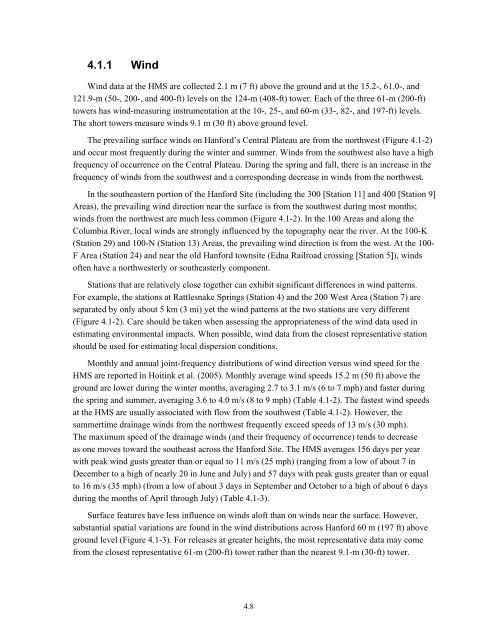Hanford Site National Environmental Policy Act (NEPA) - Pacific ...
Hanford Site National Environmental Policy Act (NEPA) - Pacific ...
Hanford Site National Environmental Policy Act (NEPA) - Pacific ...
You also want an ePaper? Increase the reach of your titles
YUMPU automatically turns print PDFs into web optimized ePapers that Google loves.
4.1.1 Wind<br />
Wind data at the HMS are collected 2.1 m (7 ft) above the ground and at the 15.2-, 61.0-, and<br />
121.9-m (50-, 200-, and 400-ft) levels on the 124-m (408-ft) tower. Each of the three 61-m (200-ft)<br />
towers has wind-measuring instrumentation at the 10-, 25-, and 60-m (33-, 82-, and 197-ft) levels.<br />
The short towers measure winds 9.1 m (30 ft) above ground level.<br />
The prevailing surface winds on <strong>Hanford</strong>’s Central Plateau are from the northwest (Figure 4.1-2)<br />
and occur most frequently during the winter and summer. Winds from the southwest also have a high<br />
frequency of occurrence on the Central Plateau. During the spring and fall, there is an increase in the<br />
frequency of winds from the southwest and a corresponding decrease in winds from the northwest.<br />
In the southeastern portion of the <strong>Hanford</strong> <strong>Site</strong> (including the 300 [Station 11] and 400 [Station 9]<br />
Areas), the prevailing wind direction near the surface is from the southwest during most months;<br />
winds from the northwest are much less common (Figure 4.1-2). In the 100 Areas and along the<br />
Columbia River, local winds are strongly influenced by the topography near the river. At the 100-K<br />
(Station 29) and 100-N (Station 13) Areas, the prevailing wind direction is from the west. At the 100-<br />
F Area (Station 24) and near the old <strong>Hanford</strong> townsite (Edna Railroad crossing [Station 5]), winds<br />
often have a northwesterly or southeasterly component.<br />
Stations that are relatively close together can exhibit significant differences in wind patterns.<br />
For example, the stations at Rattlesnake Springs (Station 4) and the 200 West Area (Station 7) are<br />
separated by only about 5 km (3 mi) yet the wind patterns at the two stations are very different<br />
(Figure 4.1-2). Care should be taken when assessing the appropriateness of the wind data used in<br />
estimating environmental impacts. When possible, wind data from the closest representative station<br />
should be used for estimating local dispersion conditions.<br />
Monthly and annual joint-frequency distributions of wind direction versus wind speed for the<br />
HMS are reported in Hoitink et al. (2005). Monthly average wind speeds 15.2 m (50 ft) above the<br />
ground are lower during the winter months, averaging 2.7 to 3.1 m/s (6 to 7 mph) and faster during<br />
the spring and summer, averaging 3.6 to 4.0 m/s (8 to 9 mph) (Table 4.1-2). The fastest wind speeds<br />
at the HMS are usually associated with flow from the southwest (Table 4.1-2). However, the<br />
summertime drainage winds from the northwest frequently exceed speeds of 13 m/s (30 mph).<br />
The maximum speed of the drainage winds (and their frequency of occurrence) tends to decrease<br />
as one moves toward the southeast across the <strong>Hanford</strong> <strong>Site</strong>. The HMS averages 156 days per year<br />
with peak wind gusts greater than or equal to 11 m/s (25 mph) (ranging from a low of about 7 in<br />
December to a high of nearly 20 in June and July) and 57 days with peak gusts greater than or equal<br />
to 16 m/s (35 mph) (from a low of about 3 days in September and October to a high of about 6 days<br />
during the months of April through July) (Table 4.1-3).<br />
Surface features have less influence on winds aloft than on winds near the surface. However,<br />
substantial spatial variations are found in the wind distributions across <strong>Hanford</strong> 60 m (197 ft) above<br />
ground level (Figure 4.1-3). For releases at greater heights, the most representative data may come<br />
from the closest representative 61-m (200-ft) tower rather than the nearest 9.1-m (30-ft) tower.<br />
4.8

















